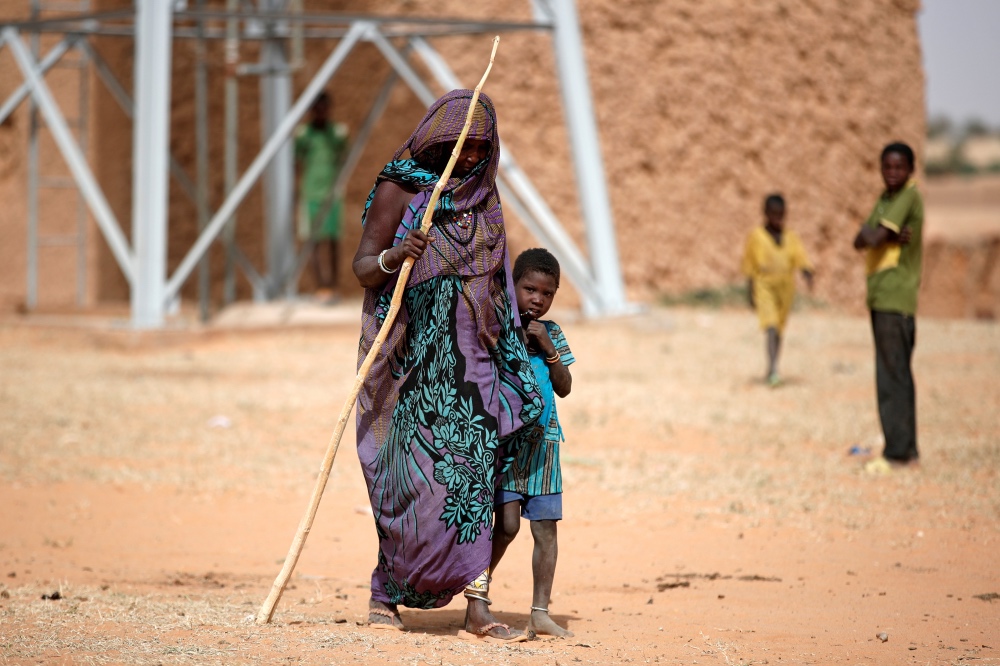London, UK
Thomson Reuters Foundation
Nearly four decades ago, farmers in the small central Malian village of Dlonguebougou grew their millet crops with little more than hoes, and local mud-hut shops sold just the basics: salt, sugar, tea, cola nuts, kerosene and cigarettes.
The vast empty reaches of the Sahel, stretching north into the Sahara Desert, offered endless grazing and land for farm expansion, residents told Camilla Toulmin, a researcher who has chronicled the community since the early 1980s.

A woman walks in the street of Tin Hama, Mali, during the regional anti-insurgent Operation Barkhane, on 19th October, 2017. PICTURE: Reuters/Benoit Tessier/File photo
Today, however, life is changing in Dlonguebougou, as in many other villages across the drylands of West Africa.
Some mud homes now sport satellite television dishes and solar panels. Ploughs and donkey carts make work easier in the fields, and vendors sell everything from mobile phone cards to motorcycle parts.
“There’s been an explosion in shopping” – and most inhabitants think life has improved, said Toulmin, who last visited the village, about 50 kilometres north of the Niger River, in 2017.
But not all the changes have been positive.
Increasingly erratic rainfall linked to climate change – from longer droughts to heavy flooding last growing season – have made it harder to get a good harvest, said Toulmin, former director of the London-based International Institute for Environment and Development.
Deadly clashes with pastoralist neighbours over land and resources are growing, and a breakdown of the ancient exchange of animal dung for water and grazing is leaving farm soils poorer, said Bara Gueye, a Senegalese rural economist with IIED who works on the region.
A rise in jihadist conflict also has driven away the tourists and development agencies that once provided extra income in a region with a fast-growing population and legions of young job-seekers, Toulmin said.
A government decision to hand big chunks of land to Chinese investors in a bid to shore up food production, meanwhile, is displacing local farmers, forcing many onto Dlonguebougou’s territory in an effort to survive, she said.
Now families who once saw the land around them as an endless resource say “the bush is finished”, said Toulmin, an economist who published a book on the village of 1,600 people this year.
“What’s been happening in this one village represents a microcosm of the more powerful forces operating across the region,” she told an online event on Wednesday.
Hunger surge
Communities in Africa’s Sahel – a dry stretch of land below the Sahara Desert – face worsening struggles, including this year the arrival of the coronavirus pandemic.
Ndidi Okonkwo Nwuneli, a managing partner with Sahel Consulting Agriculture and Nutrition Ltd, a research and advisory organisation based in Nigeria, said COVID-19 lockdowns had disrupted food supply chains and already fragile food security across Africa.
“We’ve seen food prices rise by 10 per cent to 50 per cent, and in my own country [of Nigeria], in some value chains like cassava, by 100 per cent,” she told a separate online event this week.
That is leading to more hunger and malnutrition, she said, with the Economic Community of West African States predicting the number of food-insecure people in the region will surge from 17 million this month to 50 million by August.
“This is quite alarming,” she said.
Mali’s farmers say food production is at risk as economic fallout from the coronavirus pandemic has sent the price of cotton – a key crop – plummeting, leaving them struggling to afford farm inputs, even with government help.
The West African nation has recorded about 1,885 cases of COVID-19 and just over 100 deaths from the respiratory disease, according to a Reuters tally.
Gueye said income from activities other than farming is increasingly important for communities in the Sahel, but outside opportunities are shrinking due to conflict and COVID-19.
“It’s a very critical household management challenge that all the rural communities are facing now,” he said.
Temporary migration during the dry season to find work and additional income in cities is a long-standing part of life for young men and women in the region, Toulmin said.
But even in more peaceful periods, trips that once lasted three or four months now extend to nine, particularly as droughts worsen, she said.
Some migrants never come back, with Dlonguebougou youth ending up not just in Mali’s cities but in neighbouring countries and even Europe, she said.
The region’s less-predictable rainfall, linked to climate change, and shrinking access to dung for fertiliser meant “millet yields have tumbled catastrophically” in recent years with “major consequences for food security”, she said.
Farmers are searching for more resilient varieties of millet, she added, but if drier conditions persist or worsen, farming north of the Niger River may give way to herding.
“The farming system is under real stress,” she said.
– Additional reporting by THIN LEI WIN




